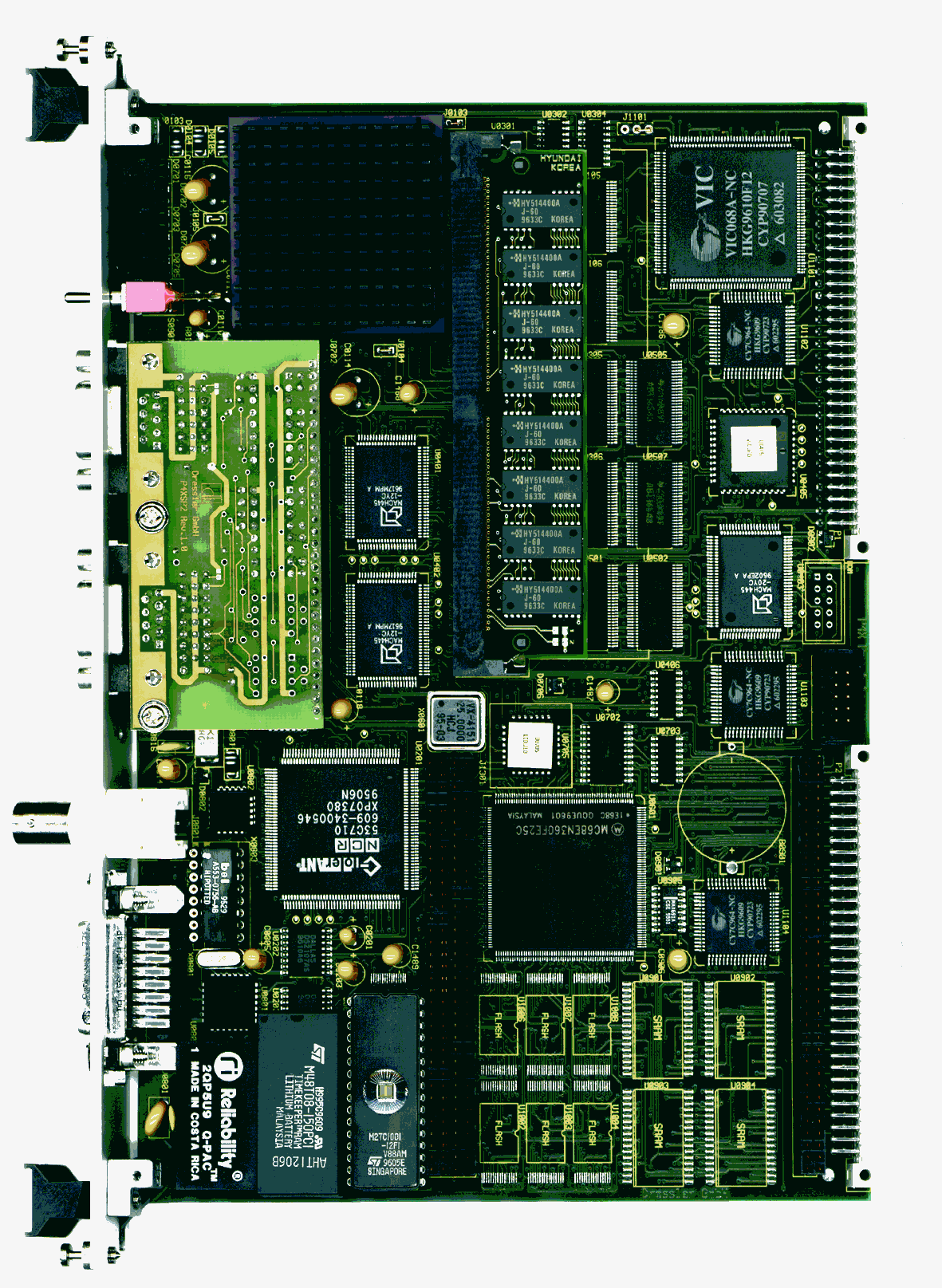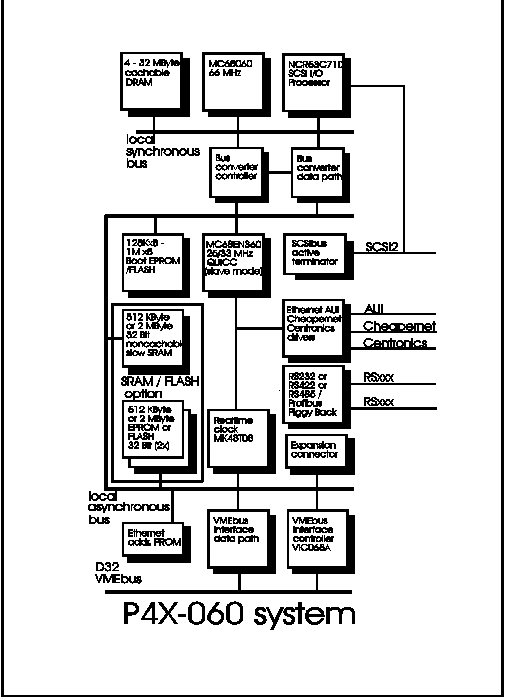P4x-060

Highlights
The "P4X 060 system" is a 6U VMEbus board build around the
Motorola MC68060 microprocessor.
It is ideal for high-end embedded real-time monitor, control and server
applications. The combination of the high performance MC68060 and the IO
versatility of the QUICC puts low cost features into a high performance
single board VMEbus computer. The usage of the MC68EN360 QUICC as intelligent
multiple IO controller provides a large offering of interfaces: Ethernet,
parallel port, three serial ports configurable as RS232, RS422, second
ethernet or Profibus. The VMEbus interface uses the VIC068A gate array
to provide a complete state of the art backplane transmission media. Mass
storage devices can be handled by the onboard intelligent fast SCSI-2 controller.
A key feature of the P4X is its double local bus structure which permits
to each component to work at its optimum throughput level.

Features
- 32 bit microprocessor MC68060,
integrated FPU, MMU, 8 KB data and 8 KB program cache
- clock rate : 40 Mhz (40 Mhz synchronous
bus clock rate)
- main memory :
- 1x72 pin standard SIMM socket for up
to 32 Mbyte dynamic ram module
- byte parity (optional)
- EDO DRAM controller
- accessible from the VMEbus
- 8 bit fast SCSI-2 bus interface with 32
bit synchronous bus DMA and intelligent SCSI SCRIPT processor
- bus structures:
- synchronous bus for main memory and
SCSI DMA operations with maximum troughput
- asynchronous bus for peripheral and
VMEbus operations
- bus converter for transparent cycle
translation between the two local busses
- MC68EN360 Quad Integrated Communications Controller
(QUICC) used in slave operation mode providing timers, ethernet, serial and
parallel ports
- Ethernet AUI port or cheapernet
interface
- three serial ports configurable as
RS232, RS422, second ethernet and Profibus via serial piggyback module
- Centronics compatible parallel interface
- 32 bit, 512 Kbyte or 2 MByte SRAM bank
with battery backup
- two 32 bit, in circuit programmable
flash memory banks with 512 Kbyte or 2 Mbyte capacity each
- 8 bit wide JEDEC socket for eprom or
flash memory
- 8K x 8 NVRAM and time-of-day clock with
battery backup
- 64 Byte PROM containing a unique
ethernet address
- VIC068A VMEbus interface gate array and
CY7C964 data and address path companion chips providing a complete
state-of-the-art VMEbus interface
- local asynchronous bus expansion
connector for mezzanine card
- 10 LED indicators for function and error
monitoring
- reset and abort switch on front panel
- easy connection of SCSIbus, printer and
remote reset switch via J2 backplane connector
VMEbus Interface
The "P4X 060 system" VMEbus interface
has been optimized for operation in a multiprocessor environment. By using
the VIC068A gate array, more than just the standard VMEbus functions are
supported. One of these additional features is the message passing mechanism
which allows together with the main memory slave capability the efficient
implementation of multiprocessor systems.
The VIC068A chip supports all standard data transfer
modes of the VMEbus as master and slave interface. Additionally 32 bit
block transfer is supported. The write posting feature provides a major
relief of the cpu or the bus master. Data that has to be transferred via
the VMEbus is buffered in fast latches and, afterwards, transferred without
any further interaction of the cpu - any unnecessary cpu cycles are avoided.
The "P4X 060 system" has a software
configurable VMEbus interrupter and interrupt handler module. The following
parameters may be selected : priority of an interrupt request, and the
number and priority of any interrupt request to be handled. This way every
possible interrupt structure may be applied, either a distributed or a
central interrupt system.
The
board is able to assume all functions of a VMEbus system controller : generation
of the system clock, reset function, watchdog timer, iack daisy chain driver,
and four level arbitration (single level, priority, round robin).
Peripheral Interfaces
The 8 bit fast SCSI interface may be used
to connect up to seven mass storage devices (hard disks, optical disks tapes,
and floppy disks). The bus is controlled by the 53C710 chip. The risk kernel
contained in this component allows hardware independent programming by the SCSI
SCRIPT language. The cpu load gets reduced, since the 53C710 relieves it from
controlling the SCSIbus protocol.
The communication channels are implemented
using the Motorola MC68EN360 / QUICC controller chip.
The QUICC delivers the ethernet / IEEE
802.3 protocol on the first SCC channel. An external manchester encoder is
installed on the board.
The "P4X 060 system" offers two different
network media interfaces :
- AUI attachment unit interface for
connection of an external transciever (via DSUB15)
- 10BASE2 thin ethernet (also called
cheapernet) via BNC connector
The P4X has three serial ports which may
configured with different line driver types by means of a serial piggyback
module.
Actually five piggyback options are
available :
| first channel (SCC2) |
second channel (SCC3) |
third channel (SCC4) |
designation |
| RS232 |
profibus
(isolated RS485) |
- |
P4XSP1 |
| RS232 |
RS232 |
- |
P4XSP2 RS232
option |
| RS232 |
RS422 |
- |
P4XSP2 RS422
option |
| RS232 |
RS232 |
Second
Ethernet AUI |
P4XSP3 |
| RS232 |
RS232 |
RS232 |
P4XSP4 |
The standard delivery is with two RS232
ports installed.
In order to connect a printer, a centronics
compatible parallel interface is provided.
The local asynchronous bus is routed to the
mezzanine board expansion connector.
The P4XM M-module carrier board can be
plugged into this slot to permit the construction of compact controller systems
without loading the VMEbus.
Manufacturing quality
The SimTech products are manufactured
using high quality components. Each board is submitted to a 12 hours burn
in..
Technical specifications
Main
processor
- 32 bit microprocessor Motorola MC68060,
integrated FPU, MMU, 8 KB data and 8 KB program cache
- clock rate : 40 Mhz (40 Mhz synchronous
bus clock rate)
Main
memory
- 72 pin standard SIMM socket for up to 32
Mbyte dynamic ram module
- 1M x 36, 2M x 36, 4M x 36, 8M x 36 PS2
compatible modules may be used
- byte parity
- accessible from the VMEbus
IO
processor
- Motorola MC68EN360 Quad Integrated Communications
Controller
(QUICC) used in slave operation mode providing timers, ethernet, serial and
parallel ports
- clock rate : 25 MHz
Static
RAM
- One 32 bit bank of battery backed low
power static ram.
- The total data capacity is 512 Kbytes or
2 Mbytes..
- The data is held during power down with
a lithium type accumulator.
- The typical backup time is 3800 hours
(160 days).
Flash
memory
- Two banks of 32 bit wide flash memory.
- total capacity of 512 Kbytes or 2 Mbytes
per bank.
- 5V operation for read, write and erase.
- minimum of 100 000 write/erase
cycles.
Boot
eprom
- A conventional JEDEC compatible 32
socket is available for use as boot eprom.
- The following memory chips can be used :
| Designation |
type |
bit capacity |
byte capacity |
| 27C010 |
EPROM |
1 M |
128 K
|
| 27C020 |
EPROM |
2 M |
256 K
|
| 27C040 |
EPROM |
4 M |
512 K
|
| 29F010 |
5 V
FLASH |
1 M |
128
K |
| 29F040 |
5 V
FLASH |
4 M |
512
K |
- The flash memories are in circuit
programmable with +5V only supply for read, write and erase.
VMEbus (IEEE STD
1014)
- VIC068A VMEbus interface gate array and
CY7C964 data and address path companion chips
- DTB master : A16-A32, D08-D32, BLK
- DTB slave : A16-A32, D08-D32, BLK
- arbiter : RR/PRI
- interrupt handler : IRQ1-7
- interrupt generator : level 1 to 7
- system controller : yes, jumperable
- interprocessor communication support
including four global mailbox interrupts, four module mailbox interrupts and
five mailbox registers
- master and slave write posting
SCSIbus
- controller : 53C710
- 8 bit fast SCSI-2 bus interface
- 32 bit synchronous bus DMA
- intelligent SCSI SCRIPT processor
- active termination
- device connections via J2 backpanel
P4XBP
Ethernet
- controller : SCC1 on QUICC
- 64 byte prom containing unique ethernet
address (also available as system ID)
- manchester encoder : AM7992B
- AUI port DB15 female connector on front
panel
- cheapernet transciever : AM7996
- isolated 10BASE2 BNC connector on front
panel
- second ethernet AUI port via P4XSP3
piggy back
Counters /
Timers
- controller : QUICC
- periodic interrupt timer PIT
- four general purpose 16 bit timers or
two 32 bit timers
Watchdog
Timers
- separate cycle watchdog timer on each of
the three busses : synchronous, asynchronous and VMEbus.
Asynchronous serial
ports
- controller : SCC2 and SCC3 on QUICC
- RS232 or RS422 drivers
- input termination resistors for RS422
drivers
- DB9 male connectors on front pane
Profibus
port
- controller : SCC3 on QUICC
- software support via QUICC RAM microcode
option
- isolated RS485 interface
- termination and idle bus state detection
hardware
- DB9 female connector on front panel
Parallel
Port
- controller : PIP on QUICC
- Centronics compatible
- bipolar driver devices external to the
QUICC for industry environment compatibility
- printer connection via J2 backpanel
P4XB
Mezzanine Card
Slot
- complete asynchronous bus
- IDMA channel
- interrupt channel
- bus request / grant channel
Board
Size
- Card height 233,4 mm (9,2 in.)
- Card depth 160,0 mm (6,3 in.)
- Front panel height 261,8 mm ( 10,3 in.)
- Front panel width 19,8 mm (0,8 in.)
without mezzanine card
- Front panel widht 39,6 mm (1,6 in.) with
mezzanine card
Power
Requirements
- Only the +5V supply is required for
normal operation.
- +12V are required when external ethernet
transciever is connected to the AUI port
other frontpanel
elements
- 10 LED indicators (3 are user
programmable)
- reset switch
- abort switch
Backpanel elements
(on P4XBP)
- SCSIbus connector
- Centronics connector
- remote reset switch connector
Environmental
- operating temperature : 0° C to + 55°C,
forced air cooling
Regulations
- EMI / RFI protection filters to ease
customer system integration
Ordering information
1. P4X base board
:
standard configurations :
- 060 CPU
- EDO DRAM without parity
- QUICC in slave mode
- 128K boot eprom
- SCSI Interface
- VMEbus Interface
- no SRAM
- no Flash
| cpu type |
cpu speed |
DRAM size |
SRAM size |
Flash size |
ordering code |
| MC68060 |
40
MHz |
4
Mbyte |
0 |
0 |
P4X_060_40_4_0_0 |
| MC68060 |
40
MHz |
8
Mbyte |
0 |
0 |
P4X_060_40_8_0_0 |
| MC68060 |
40
MHz |
16
Mbyte |
0 |
0 |
P4X_060_40_16_0_0 |
| MC68060 |
40
MHz |
32
Mbyte |
0 |
0 |
P4X_060_40_32_0_0 |
other options on request :
- 512 K or 2 M SRAM
- 512 K, 1 M, 2 M or 4 M Flash
- board without VMEbus
interface
2. P4X serial piggyback
standard configuration :
P4XSP2 RS232 option
other options on request :
| first channel (SCC2) |
second channel (SCC3) |
third channel (SCC4) |
designation |
| RS232 |
profibus
(isolated RS485) |
- |
P4XSP1 |
| RS232 |
RS232 |
- |
P4XSP2 RS232
option |
| RS232 |
RS422 |
- |
P4XSP2 RS422
option |
| RS232 |
RS232 |
Second
Ethernet AUI |
P4XSP3 |
| RS232 |
RS232 |
RS232 |
P4XSP4 |
Data sheet revision : 1.2
 Back
Back
Homepage


